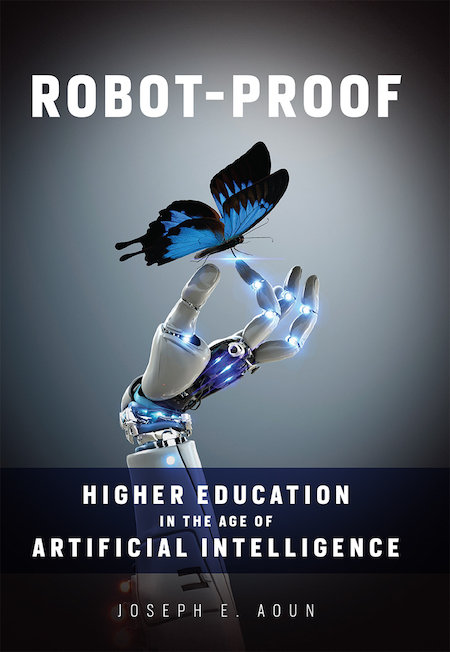The advancement of artificial intelligence means more high-skilled jobs are within the capability of smart machines. How should higher education adapt to prepare students to thrive in this new and fast-changing economy?
Northeastern University President Joseph E. Aoun explores this challenge in his new book, Robot-Proof: Higher Education in the Age of Artificial Intelligence. Below is an excerpt from the book that addresses the rise of A.I., higher education’s transformation, and the future of work.

Chapter 3
The season of discontent is not winter. According to the popular professional networking site LinkedIn, it is October, the month in which worldwide job applications spike. In homage to this annual burst of restlessness, LinkedIn delves through its copious data on hiring and recruiting activity every autumn to compile a list of skills that have proved most in demand by employers for that year. According to its 2016 version of “The Top Skills That Can Get You Hired Today and Tomorrow,” the most desirable skill in the global job market is “Cloud and Distributed Computing.” Next up is “Statistical Analysis and Data Mining,” with “Web Architecture and Development Framework” rounding out the top three. The list continues in a similar vein: “Middleware and Integration Software,” “User Interface Design,” “Network and Information Security.” According to LinkedIn’s list, every single one of the ten most desirable skills on the planet is technological.
Even as technology-related jobs continue their ascendance and as technology is integrated ever more thoroughly into every industry, the fact remains that technology will not provide jobs for everyone. Even if technological work were available to everyone who is qualified, the advance of robots, advanced machines, and artificial intelligence suggests that ultimately, technology itself will become the best candidate for many jobs. A great many economists, journalists, and thinkers argue that deep learning in machines and the exponential growth of big data and processing power are rendering the human mind an economic relic. In Rise of the Robots: Technology and the Threat of a Jobless Future, Silicon Valley entrepreneur and author Martin Ford paints a convincing picture of the tsunami of automation that is about to wash away white-collar jobs. “Exponential progress is now pushing us toward the endgame,” he writes. If technology can replace human beings on the job, it will. Preventing business owners from adopting labor-saving technology “would require modifying the basic incentives built into the market economy.”
Ford and the others are entirely correct that machines will destroy jobs. Historically, this has been the case, going back to the days of the Luddite weavers. Nonetheless, technology also has given rise to new industries, bringing new forms of employment. Once again, this is the case, as can be seen with the invention of jobs that did not exist a generation ago, before the rise of the Internet era, such as search-engine optimization specialists or user-experience designers. But as journalist Ryan Avent observes in his 2016 book, The Wealth of Humans: Work, Power, and Status in the Twenty-first Century, “New technologies will create new, good work, which might often benefit the less skilled. But it will not be scalable mass employment. And it will not solve the problem of labor abundance.” Despite the invention of unforeseen jobs, the confluence of “automation, globalization, and the rising productivity of a highly skilled few” will continue to suppress the value of human labor across the globe.
Nonetheless, when these analysts and futurists argue that the current technological revolution is different and that the value of human labor will be irretrievably lost, they are overlooking two salient facts. First, much of the world remains terra incognita. There is more to find, in the heavens and on earth, than we can dream of in our blinkered present. We have a universe of scientific secrets to uncover and shoreless oceans of knowledge yet to cross. We have an infinite canvas to paint and endless music to play. From curing disease to restoring the environment to writing the next great novel, there is everything left to do. And for most of us, this involves finding fairly compensated, satisfying employment. Thus, even as machines take over routine labor, freeing us from repetitive or mundane tasks, human beings have a great deal left to occupy them. The only question is whether we possess the tools to accomplish it.
This relates to the second point that many of the current analysts overlook—the historic role played by education in elevating the majority of people to the next level of economic development. In the nineteenth century, free, public elementary schools raised the mass of Americans out of illiteracy. When technological progress built steam, public secondary schooling helped the merely literate ascend to the next rung of the ladder, giving them basic skills they needed to work in the new industries. Then, as corporate America rose in the postwar order, public colleges and universities raised mass education levels another notch again, teaching a sizeable portion of the workforce advanced knowledge skills. Now, once more, technology is raising the educational bar. If the work of tomorrow demands more from us, we must demand more from our education—particularly at the college level.
Consequently, an education for the digital age needs to focus not just on technology and understanding what technology can do but also on what it cannot do—at least for now and perhaps never. In other words, a robot-proof education nurtures our unique capacities as human beings. And the most elevated of all human capacities is the one that may be the most elusive and difficult to define and therefore is trickiest to teach. This is humanity’s unique talent for creativity.